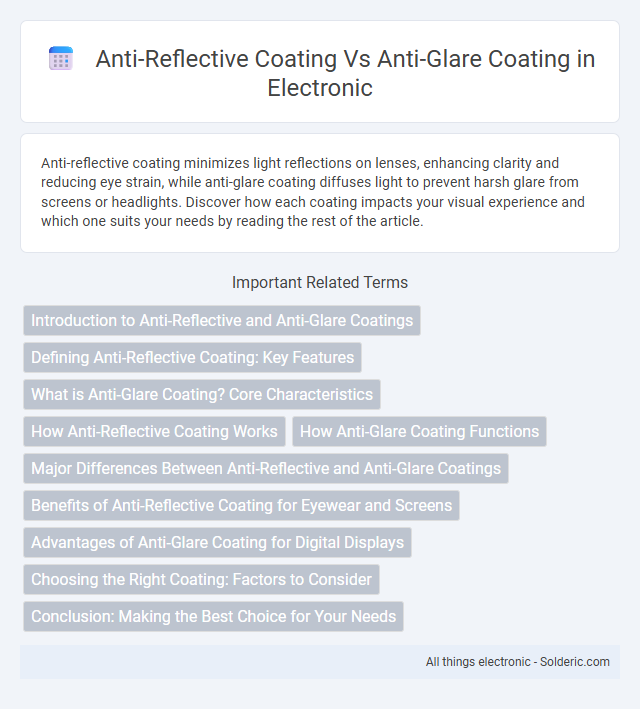Anti-reflective coating minimizes light reflections on lenses, enhancing clarity and reducing eye strain, while anti-glare coating diffuses light to prevent harsh glare from screens or headlights. Discover how each coating impacts your visual experience and which one suits your needs by reading the rest of the article.
Comparison Table
| Feature | Anti-Reflective Coating (AR) | Anti-Glare Coating (AG) |
|---|---|---|
| Purpose | Reduces reflections and glare on lenses or screens | Diffuses light to minimize glare and surface reflections |
| Technology | Multi-layer thin films reducing surface reflections | Matte or etched surface creating microscopic texture |
| Visual Clarity | Enhances sharpness and brightness | Reduces sharpness slightly due to light diffusion |
| Best Use | Eyeglasses, camera lenses, smartphone screens | Computer monitors, TV screens, reading devices |
| Maintenance | Requires regular cleaning to maintain clarity | Smudge-resistant but may wear over time |
| Cost | Typically higher due to advanced coatings | Generally lower and easier to apply |
Introduction to Anti-Reflective and Anti-Glare Coatings
Anti-reflective coatings reduce surface reflections on lenses by using thin layers to minimize light bounce, enhancing visual clarity and reducing eye strain. Anti-glare coatings diffuse incoming light to prevent intense brightness and glare, improving comfort in bright environments. Understanding the difference helps you choose the right coating to optimize your vision for specific lighting conditions.
Defining Anti-Reflective Coating: Key Features
Anti-reflective coating reduces surface glare by minimizing light reflection on lenses, enhancing visual clarity and contrast. It is commonly used on eyeglasses, camera lenses, and electronic screens to improve visibility and reduce eye strain. Key features include increased light transmission, reduced reflections, and improved aesthetic appeal by making lenses appear nearly invisible.
What is Anti-Glare Coating? Core Characteristics
Anti-glare coating reduces screen reflections by diffusing ambient light, improving visibility and reducing eye strain in bright environments. Its core characteristics include a matte finish that scatters light and minimizes sharp reflections, making it ideal for electronic displays such as smartphones, computers, and TVs. Unlike anti-reflective coatings, anti-glare coatings typically do not eliminate reflections entirely but focus on maintaining screen readability under various lighting conditions.
How Anti-Reflective Coating Works
Anti-reflective coating works by applying multiple thin layers of metal oxides to your lenses, which reduce surface reflections by causing light waves to cancel each other out. This minimization of reflections improves visual clarity and reduces eye strain, especially in bright environments or when using digital screens. Unlike anti-glare coatings that scatter light, anti-reflective coatings specifically target and eliminate reflections for clearer, sharper vision.
How Anti-Glare Coating Functions
Anti-glare coating functions by diffusing light that hits the lens surface, reducing reflections and minimizing glare to improve visual comfort and clarity in bright environments. This coating scatters incoming light rays, preventing sharp reflections from distracting your vision, especially when using digital screens or driving in sunlight. Unlike anti-reflective coatings that selectively reduce surface reflections, anti-glare coatings provide a matte finish that lowers eye strain by softening harsh light sources.
Major Differences Between Anti-Reflective and Anti-Glare Coatings
Anti-reflective coatings reduce reflections by minimizing light bounce on lenses, enhancing clarity and improving vision, especially in low-light conditions, while anti-glare coatings diffuse light to reduce screen glare and eye strain. Anti-reflective coatings are primarily used in eyeglasses and camera lenses to increase transparency, whereas anti-glare coatings are commonly applied on screens and monitors to decrease visible glare. Understanding their functional differences helps in selecting the right coating for improved visual comfort and performance.
Benefits of Anti-Reflective Coating for Eyewear and Screens
Anti-reflective coating enhances eyewear and screen visibility by reducing surface reflections, which improves clarity and reduces eye strain during prolonged use. This technology increases light transmission, leading to sharper vision and better color accuracy for users in various lighting conditions. Anti-reflective coatings also minimize glare from artificial and natural light sources, making screens and lenses more comfortable to view and improving overall user experience.
Advantages of Anti-Glare Coating for Digital Displays
Anti-glare coating minimizes screen reflections and glare, enhancing visibility and reducing eye strain during prolonged use of digital displays. This coating disperses ambient light, providing clearer and more comfortable viewing in bright environments. It improves contrast and color perception, making images and text easier to see without distortion.
Choosing the Right Coating: Factors to Consider
When selecting between anti-reflective coating and anti-glare coating, consider the primary use of your device or eyewear, as anti-reflective coatings reduce reflections and improve clarity, while anti-glare coatings diffuse harsh light to minimize eye strain. Evaluate the lighting environment, with anti-reflective coatings excelling in low-light or indoor settings and anti-glare coatings offering benefits under bright, direct sunlight. Durability, maintenance, and cost are also essential factors, as anti-reflective coatings often require more careful handling and may be pricier compared to anti-glare options.
Conclusion: Making the Best Choice for Your Needs
Choosing between anti-reflective coating and anti-glare coating depends on your specific vision needs and environmental conditions. Anti-reflective coatings reduce lens reflections, enhancing clarity and visual comfort, ideal for night driving and screen use. Anti-glare coatings diffuse light to minimize harsh glare, making them better suited for bright outdoor environments and reducing eye strain.
Anti-Reflective Coating vs Anti-Glare Coating Infographic

 solderic.com
solderic.com